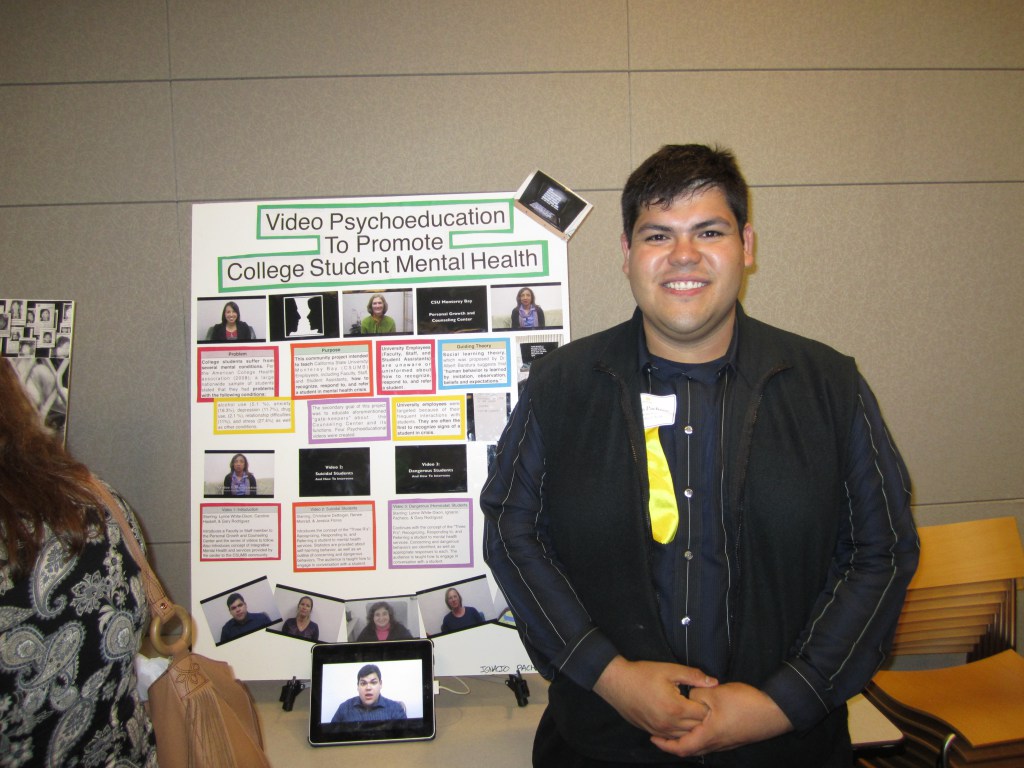If you happen to follow me on my professional Twitter account (aside from this website’s Twitter account), you will know that I was recognized for having one of the top community projects in my MSW Program for the year. I wanted to share what resulted from the start of this project.

Proudly displaying my project at an awards ceremony
Problem
The problem that my project intended to address was to educate University Employees (staff, faculty, or student assistants at CSU Monterey Bay) in how to recognize, respond to, and refer a student in mental health crisis. Furthermore, studies (cited in my academic literature review) suggest that University Employees are gate-keepers who may react inappropriately due to lack of training, either overreacting or under-reacting.
An excerpt from my research paper states:
American College Health Association [AMCHA]), students in a large sample size identified various mental health needs that affected their school performances in the previous 12 months. These include alcohol use (5.1%), anxiety (18.3%), depression (11.7%), drug use, (2.1%), relationship difficulties (11%), and stress (27.4%) as well as other conditions (AMCHA, 2008). Unaddressed, these conditions can deteriorate into a mental health crisis. As a result University employees (including staff, faculty, and student assistants) that have the most interactions with college students may not recognize signs of a suicidal or dangerous student, know how to respond to these signs or refer the student for services.I searched the counseling websites of many Universities and did not find anyone providing this type of intervention to their campus colleagues.

Development of Psychoeducational Videos
I wanted to make training videos that would incorporate Counseling Center staff providing information to their professional colleagues as to how to recognize and appropriately respond/refer a student to mental health services. I also wanted to help the counseling center promote the safety, health, and well-being of the campus community.
Prior to producing these videos, I knew that I wanted to put them onto YouTube so that they were easily accessible to the campus community. Distance psychoeducation is a term I use to describe this type of intervention, which the intended audience can access it on demand via the internet.

Intervention: Always available
The intended goal of the intervention was to reduce agency staff’s need to have face-to-face contact with colleagues (traditional intervention delivery) and provide the intended audience with critical information, even when the agency’s staff may not be available.
Four Videos
I decided on producing four videos:
- Introduction to the Counseling Center
- How to Respond to Suicidal Behavior
- How to Respond to Homicidal/Ambiguously Dangerous Behavior
- General Intervention and Referral
Each video was designed to be watched on its own, thus there are redundancies in the second and third videos that are almost verbatim. This eliminates loss of important and crucial information if a viewer were to only see the video that pertains to their need.
If a faculty member wanted to know about suicidal behaviors, she could watch the second video. If a student assistant had concerns about a student’s ambiguously dangerous behaviors, she could watch the second video. And if a newly hired softball coach wanted to know about the counseling center, she could watch the first video.
Theory
I used Dr. Albert Bandura’s social learning theory, which suggests that “human behavior is also learned by imitation, observation, beliefs and expectations”. My aim was to increase a viewer’s self-efficacy and their belief that they could successfully intervene in recognizing, responding to, and referring a student in mental health crisis.
Any good intervention is based on a solid theory, of which Dr. Bandura’s is my favorite for understanding our own behavior and empowering us to make necessary changes for future changes.
Technical Challenges
I wanted two things to also happen in the videos: I wanted the staff member talking to the camera to present a lot of information, and I wanted them to make eye contact with the camera. Being the crafty social worker I am (and at the time, a student with a loooot of time on my hands, I came to a resolution. I built a handy-dandy teleprompter that incorporated my iPad.




To finish the videos, I incorporated some of the same techniques described in the Process section of my previous blog post about my interview with Ms. Estella.
Results
Video 1: Introduction to the Counseling Center
Video 2: How to Respond to Suicidal Behavior
Video 3: How to Respond to Homicidal/Ambiguously Dangerous Behavior
Video 4: General Intervention and Referral
Feedback
The feedback I have received for this project has been amazing. I was supported by my agency in completing these videos and in evaluating it for my research project, self-efficacy was increased when measured on a scale I developed.
I was happy that these videos came out well and were well received. The fruits of my labor have blossomed strongly after months of planning and implementation. I liked that the subtitles help a viewer to follow what is being presented. A limitation of this intervention was that YouTube compressed these videos so that they sort of look grainy. Still, the product looks well and although they are dry, they are still informative.
In Conclusion
The information presented in these videos will remain relevant for several years and is intended to help staff, faculty, and others react appropriate to students exhibiting concerning behavior. One could be asked to watch the videos as part of the University’s training, which would serve the student population well.
The intervention has a lot of information presented to the audience, however, it is hoped that the viewer will feel a sense of connection with the agency’s staff (on the videos) and can consult if he or she has concerns about a student.
I hope this project inspires others to help their communities in similar ways… through outreach in this manner.









Iggy, this is really great and I love how you used YouTube. I hope more MSW’s and social workers in general are using social media like this and in other unique ways. Congrats my friend.
This is an awesome and thoughtful intervention for the University community. I like that the videos were informative and also provided simple examples of good questions to engage the student in seeking help. Outstanding job!!
Thanks everyone for your love and support of me!
Great project, Iggy! I love how you use current tools and technology to upgrade learning options in the field.
Hi Iggy
Would you be happy for me to forward this to the Mental Health in Higher Education project in the UK?
Good work.
Hi Iggy,
Congrats on your work. Thought you might also be interested in the Mental Health First Aid initiative: http://www.mhfa.com.au/cms/ I am aware of some University campuses in Australia that use this program for their staff/students . . .
Cheers,
Lauren.